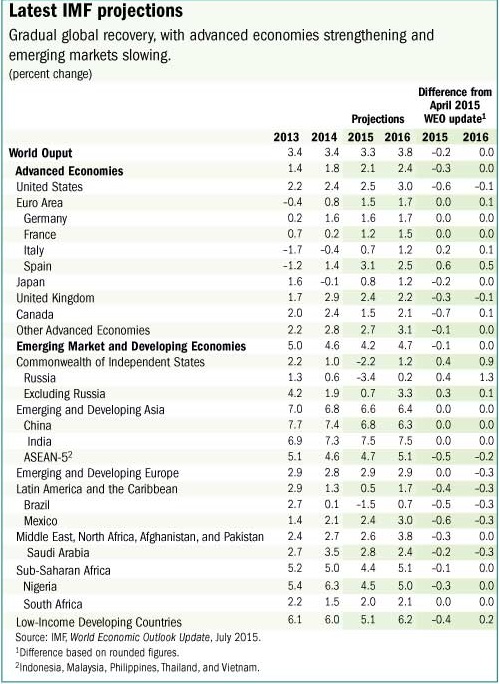![A new IMF report says a gradual recovery continues, but global growth is forecast to be slightly down for 2015, reflecting an unexpected setback to economic activity in the first quarter of 2015, mostly in North America. [UNITED NATIONS PHOTO]](https://www.eaglenews.ph/wp-content/uploads/2015/07/BLANCHARD-IMF.jpg)
IMF’s economist Olivier Blanchard said, “If you look at advanced economies, they’re actually suffering from the legacies of the crisis. Looking forward, their potential growth is clearly lower. If you look at the emerging market economies, they really have had a fairly large decrease in growth. So all in all, it’s not great. What we forecast for this year is 3.3 percent for the world economy; next year, 3.8 percent. So not too bad, not great.”
Developments in Greece have, so far, not produced strong ripples. And while timely policy action should help in managing potential contagion, some risks of a reemergence of financial stress remain.
Blanchard said, “So what’s happening in Greece is dramatic and sad, and Greece is going to have a very hard time. But for the world as a whole, Greece is a very small country. It’s less than one-half of a percent of world GDP. It’s about 2 percent of GDP of the euro zone. The mechanical linkages, be it financial or trade, are relatively limited, so the mechanical effects are going to be small. Now, what we worry about in cases like this is what Rumsfeld called the unknown unknowns, you know, the things we had not thought about which might derail something bigger.”
The increase in global growth in 2015 will be driven by stronger growth in advanced economies. Growth in these economies is forecast to increase from 1.8 percent in 2014 to 2.1 percent in 2015 (falling about 0.3 percent points short of the forecast in April), and 2.4 percent in 2016. The report notes that the unexpected weakness in North America in early 2015, which accounts for most of the growth forecast revision for 2015, will likely prove to be a temporary setback. The underlying drivers for consumption and investment in the United States—wage growth, labor market conditions, easy financial conditions, lower fuel prices, and a strengthening housing market—remain intact.
The economic recovery in the euro area is more solidly anchored, with signs of increase in both domestic demand and inflation. Growth projections were revised up for many euro area economies (e.g., Spain, Italy), but in Greece, unfolding developments are likely to take a much heavier toll on activity relative to previous expectations.
In Japan, growth in the first quarter of 2015 was stronger than expected, but much of the surprise reflected inventory accumulation. With weaker underlying momentum in real wages and consumption, the pickup in growth in 2015 is now projected to be more modest.
Growth in emerging market and developing economies is projected to slow from 4.6 percent in 2014 to 4.2 percent in 2015. The slowdown reflects the dampening impact of lower commodity prices and tighter external financial conditions—particularly in Latin America (e.g., Brazil) and oil exporters. Other factors include rebalancing in China, structural bottlenecks, and economic distress related to geopolitical factors—particularly in the Commonwealth of Independent States and some countries in the Middle East and North Africa.
In 2016, growth in emerging market and developing economies is expected to pick up to 4.8 percent, largely on account of the projected improvement in economic conditions in a number of distressed economies, including Russia and some economies in the Middle East and North Africa.
Given the distribution of risks to the near-term outlook, global growth is more likely to fall short of expectations than to surprise on the upside. The boost from lower oil prices, especially in advanced economies, however, may still offer potential gains.
Disruptive shifts in asset prices and increased financial market volatility remain important risks, also because of the associated risks of capital flow reversals in emerging market economies. Furthermore, U.S. dollar appreciation poses balance sheet and funding risks for dollar debtors, especially in some emerging market economies.
Other risks include low medium-term growth or a slow return to full employment amid very low inflation and crisis legacies in advanced economies, a sharper-than-expected slowdown in China, and spillovers to economic activity from increased geopolitical tensions in Ukraine, the Middle East, or parts of Africa.
In this setting, without the expected pickup in global growth, the IMF emphasizes that the economic policy priority must remain raising actual and potential output through a combination of demand support and structural reforms.
Blanchard said, “I think it’s well-adapted, well-chosen, specific structural reforms and they are going to vary from country to country. In some countries you need labor market reforms. And the issue is not so much to push growth, but to redistribute employment. There are countries where the youth unemployment rate is incredibly high. You need to change that. There are countries where the issue is much more in the product markets. You need to remove some of the barriers to entry. This would increase growth. The important thing here is to know exactly which ones are the most important and to do them.”
UNITED NATIONS/IMF








